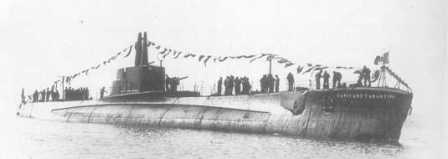The submarine VENIERO (second Italian boat with this name) was one of oceanic submariners of the class “MARCELLO”, a successful class built by the C.R.D.A. shipyard of Monfalcone, Gorizia (9 units), and O.T.O. of Muggiano, La Spezia (2 units), between 1937 and 1939.

The VENIERO on the slip.
(Photo Turrini)
The VENIERO was built in Monfalcone: laid down on January 23rd, 1937, it was launched on February 14th, 1938 and delivered to the Regia Marina on June 6th of the same year.
Operational Life
At the beginning of the war (June 10th, 1940), the VENIERO was assigned to the 1st Submarine Group, 12th Squadron based in La Spezia.
After a patrol off the southern part of Cape Artibes (from June 10th to June 21st, 1940), on July 2nd the boat, under the command of Lieutenant Commander Folco Bonamici, left La Spezia bound to Bordeaux. It crossed the Strait of Gibraltar, submerged, the night of the 7th; it was the first Italian boat to accomplish this task made difficult both by tight British surveillance and the navigational difficulties due to the strong underwater currents. These conditions were little known the Italians, and the observations made by Captain Bonamici helped the Submarine Command formulate orders for future crossing of the strait. After a fruitless patrol off the Canary Islands, the night of the 27th the VENIERO crossed again submerged the strait to return to the Mediterranean. It reached La Spezia on August 1st.
After a stop at the shipyard to complete some alterations made necessary by the specific operational conditions of the war in Atlantic, on the 28th, under the command of the new skipper Lieutenant Mario Petrani, the boat departed to reach BETASOM, the new Atlantic base in Bordeaux. During the transfer, it remained on patrol off the southern part of the Azores Islands for about a month, but without sighting any target. Later, after having reached Bordeaux, it avoided by very little two torpedoes launched by a British submarine on patrol near the estuary of the Gironde. The VENIERO arrived in Bordeaux on November 2nd, 1940.
In Atlantic, in completed 6 patrols:
On December 18th, it torpedoed and then sank with the deck gun the Greek ship ANASTASSIA of 2,883 t., but picked up 9 shipwrecked sailors.
On March 24th, 1941 it sank with the deck gun the British ship “AGNETE MAERSK” of 2,104 t. because the three torpedoes launched, perhaps due to the shallow draft of the ship, failed to explode.
When it was decided to bring back to the Mediterranean 11 of the oceanic submarines, where the situation required an increase in the number of boats, the VENIERO was included in the list. Thus, on August 8th 1941, under the command of the new skipper Lieutenant Elio Zappetta, the boat departed for Italy arriving in La Spezia on the 2nd, remaining there three months for repairs. In Mediterranean, the boat completed 7 patrols, of which one on December 19th, 1941 to transport 50 t. of foodstuff from Taranto to Bardia, in Cirenaica (Libya).

The VENIERO at sea with the new camouflage.
(Photo courtesy Erminio Bagnasco and Achille Rastelli)
The VENIERO’s last mission started May 17th, 1942 when it left Cagliari (Sardinia) to go on patrol off the Balearic Islands. On the 29th, at 16:25, it sent a discovery signal. At 23:30 sent another signal that resulted unrecognizable. From this time on, all contacts were lost. The boat was probably sunk on the 7th of June between the Balearic Island and Sardinia.
After the war, from British sources it was learned that an airplane type “Catalina” attacked an Italian submarine in the early hours of the 7th of June 1942. The same day, just before 12:00 noon, the same submarine underwent another attack while navigating on the surface, visibly damaged. Since in the positions, dates, and times the two attacks had taken place there weren’t any other Italian submariners, it is reasonable to assume that the submarine attacked by the British planes was indeed the VENIERO.
Anastassia
Ship-owner: John Livanos & Sons Ltd, manager for C. Choremis
Year Constructed: 1905
Shipyard: Bartam & Sons, Sunderland.
Previous names: King City 1927, Quarrrydene 1919
Convoy: Convoy SC15
Date lost: Sunk 20.12.40
Position: 54 24N, 19 4W
Casualties: 18 + 10 POW
Agnete Maersk
Ship-owner: MØLLER, A P Copenhagen
Year Built: 1921
Shipyard: Yarrow and Co., Scotstoun
Previous names: ex Aabenraa 1924
Change of ownership: 5.40 transferred to MoWT
Date lost: 24.3.41 Shelled at 4:09 PM
Convoy: OG56 From UK to Gibraltar
Position: 49 N 22 55 W
Casualties: 28, no survivors

















